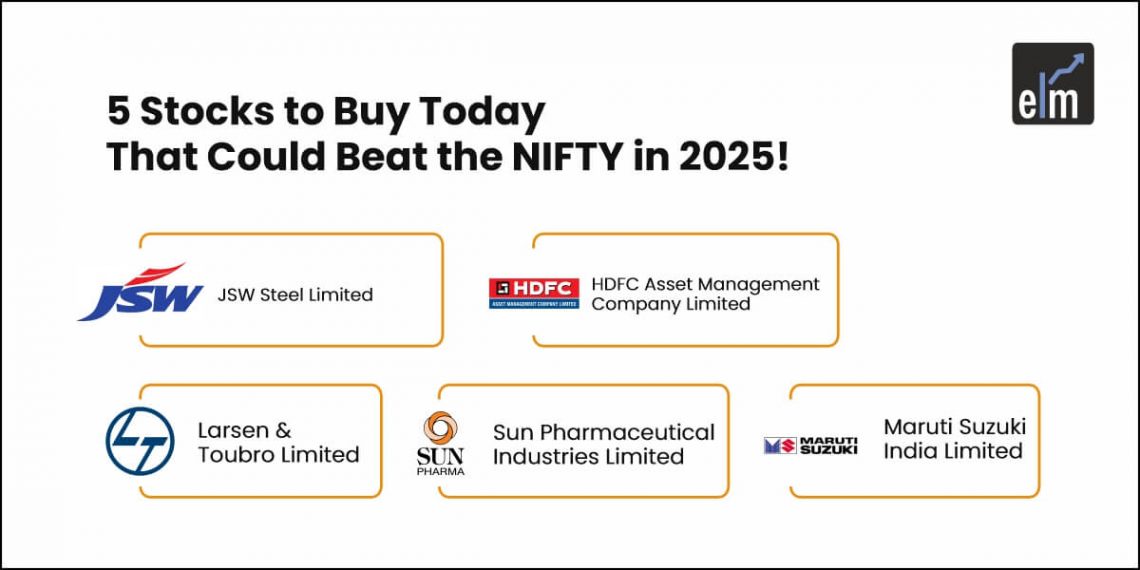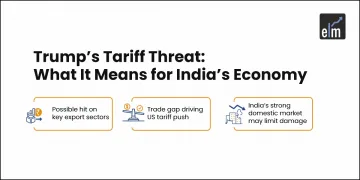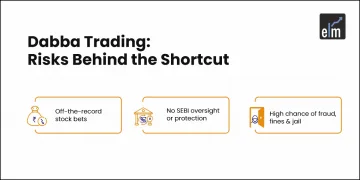Investing in the stock market requires a keen eye for opportunities that can outperform benchmark indices like the NIFTY 50. In this article, we’ll analyze five top stocks that have growth potential in 2025, backed by robust fundamentals, sectoral tailwinds, and expert market insights. We’ll also explore key market trends, financial performance, and strategic drivers. For those looking to trade efficiently, check out the Exness Go guide by TradersUnion. This guide provides valuable insights into navigating online trading platforms for a smoother investing experience.
Top 5 stocks to buy today
Here are the top 5 stocks to buy today that could beat the nifty in 2025:
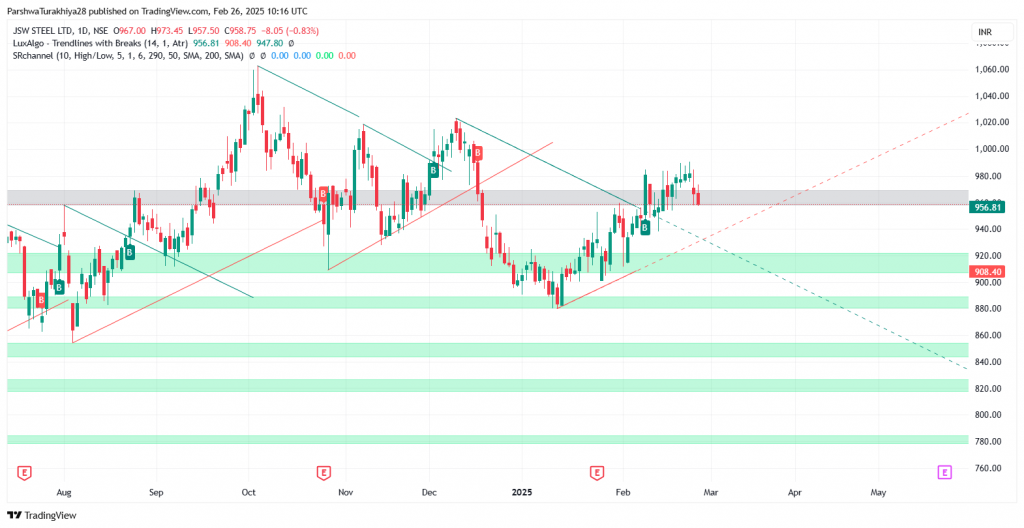
1. JSW Steel Limited (JSWSTEEL)
JSW Steel, a leading player in the Indian steel industry, has demonstrated robust performance and resilience amidst market fluctuations.
- Current performance: JSW Steel has been identified as a top trading idea, with a price-to-earnings (P/E) ratio of 11.18 and earnings per share (EPS) of ₹54.89.
- Market position: As a leading player in the steel industry, JSW Steel is poised to benefit from increased demand in the metals sector.
- Growth drivers. The anticipated rise in infrastructure projects and construction activities in India is expected to boost the steel demand, positioning JSW Steel favorably for future growth.
2. HDFC Asset Management Company Limited (HDFCAMC)
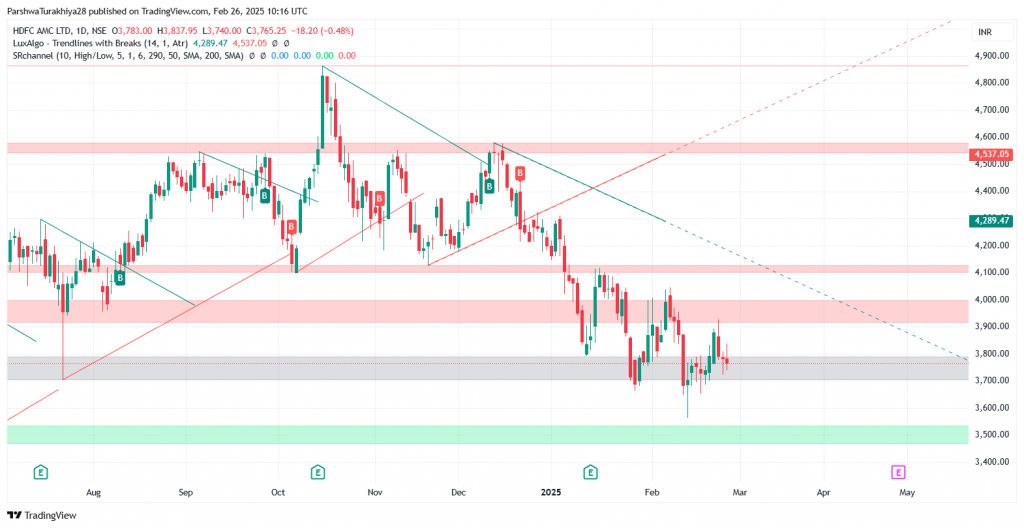
HDFC AMC is a prominent asset management company in India, known for its strong brand and extensive distribution network.
- Current performance: HDFC Bank’s shares increased by 0.47% on February 25, 2025, closing at ₹1,683.60.
- Financial stability: The bank maintains a robust balance sheet with a diversified loan portfolio, ensuring resilience against market fluctuations.
- Growth prospects: With India’s expanding economy, HDFC Bank is well-positioned to capitalize on increased demand for banking and financial services.
3. Larsen & Toubro Limited (LT)
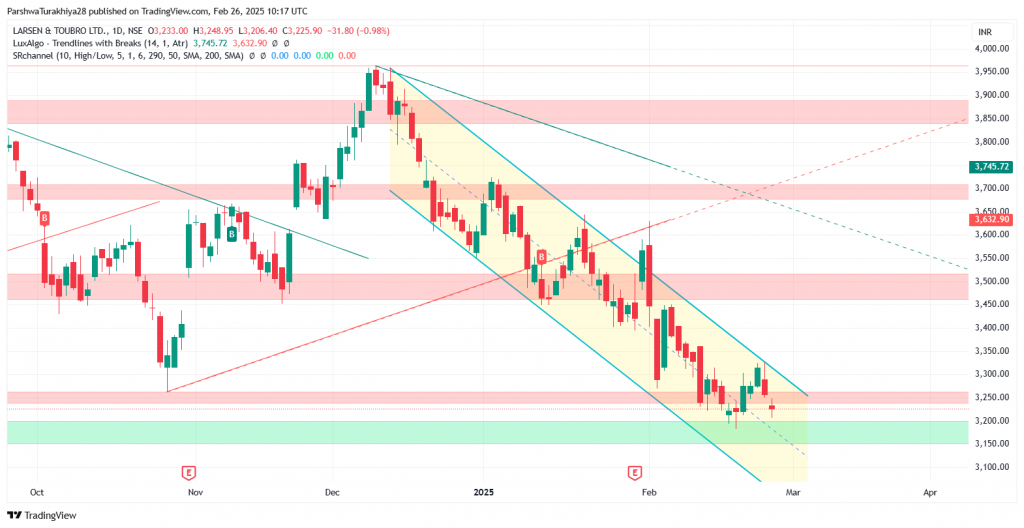
Larsen & Toubro (L&T) is a major technology, engineering, construction, and manufacturing conglomerate with global operations.
- Current performance: L&T’s shares experienced a slight decline of 0.93% on February 25, 2025, closing at ₹3,226.60.
- Order book strength: The company continues to secure significant contracts across various sectors, bolstering its order book.
- Market position: As a leading engineering and construction conglomerate, L&T is poised to benefit from ongoing and upcoming infrastructure projects.
4. Sun Pharmaceutical Industries Limited (SUNPHARMA)
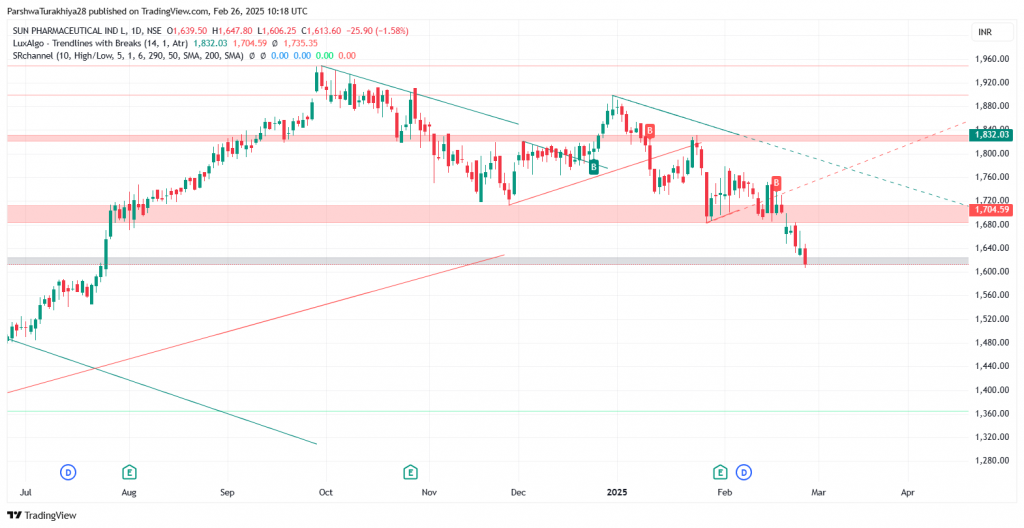
Sun Pharma is one of India’s largest pharmaceutical companies, with a strong presence in both domestic and international markets.
- Current performance: Sun Pharma’s shares experienced a decline of 1.60% on February 21, 2025.
- Financial performance: The company reported a 15% year-on-year growth in consolidated net profit for the quarter ending December 2024, reaching ₹2,903 crore.
- Market position: As one of India’s largest pharmaceutical companies, Sun Pharma is well-positioned to meet the increasing global demand for affordable healthcare solutions.
5. Maruti Suzuki India Limited (MARUTI)
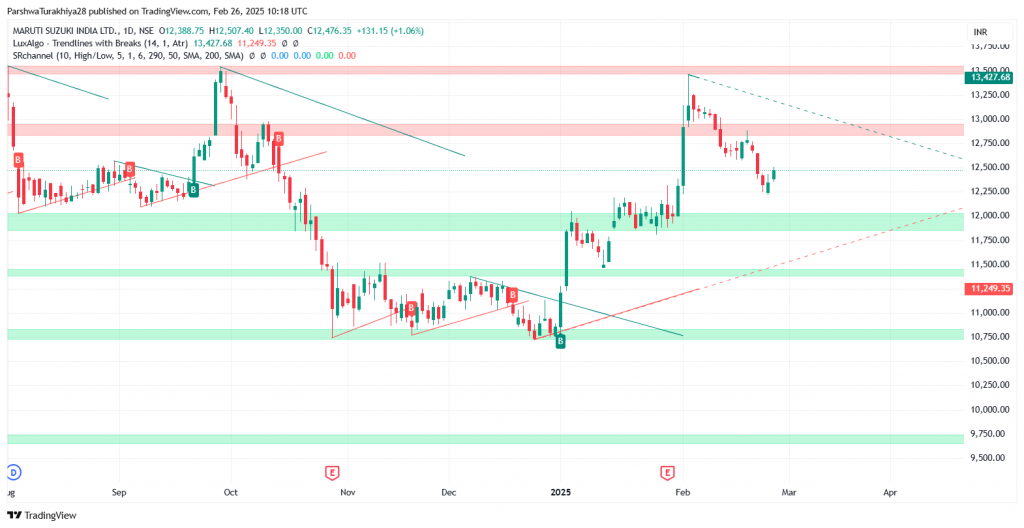
Maruti Suzuki is the leading automobile manufacturer in India, known for its wide range of vehicles catering to various market segments.
- Current performance: On February 25, 2025, Maruti Suzuki’s shares rose by 1.07%, closing at ₹12,478.70.
- Strategic expansion: The company has commenced production at its new Haryana plant, adding 250,000 units annually.
- Market position: Despite increased competition, Maruti Suzuki maintains a dominant market share in India’s passenger vehicle segment.
Why these 5 Stocks Could Outperform the NIFTY in 2025
Selecting stocks that have the potential to outperform the NIFTY 50 index requires a comprehensive understanding of market dynamics, company fundamentals, and macroeconomic factors.
1. Strong market position and brand recognition
Companies like Maruti Suzuki and HDFC AMC have established themselves as leaders in their respective sectors. Their strong brand recognition and extensive distribution networks provide a competitive edge, enabling them to capture a larger market share and drive revenue growth.
2. Favorable industry trends
The sectors these companies operate in are poised for growth due to favorable industry trends. For instance, the government’s emphasis on infrastructure development directly benefits companies like Larsen & Toubro and JSW Steel. Similarly, the increasing demand for affordable healthcare solutions globally positions Sun Pharma advantageously.
3. Robust financial health
A strong financial foundation is crucial for sustained growth. These companies have demonstrated consistent revenue growth, healthy profit margins, and efficient cash flow management. For example, HDFC AMC’s impressive net profit margin reflects its operational efficiency and profitability.
4. Strategic growth initiatives
Proactive measures such as expanding product lines, entering new markets, and investing in technology enhance these companies’ growth prospects. Sun Pharma’s strategic acquisitions and Maruti Suzuki’s focus on innovation exemplify such initiatives, positioning them well to capitalize on emerging opportunities.
5. Resilience amidst market volatility
The ability to navigate economic uncertainties and market fluctuations is a testament to a company’s resilience. These companies have showcased adaptability and robust risk management practices, enabling them to maintain stability and continue growth even during challenging times.
6. Integration of digital trading solutions
With the increasing adoption of digital trading, investors are also turning to alternative assets, such as stablecoins. Many traders now use a usdt broker to diversify their portfolio and mitigate volatility risks. This trend highlights a growing intersection between traditional stock investments and the expanding digital asset market.
How to identify high-growth stocks
Identifying high-growth stocks requires more than just looking at revenue and profit numbers. The real edge comes from analyzing hidden signals, tracking industry shifts, and identifying early indicators of business expansion before they become mainstream news. Below are specialized, targeted strategies that can help investors identify stocks with strong long-term growth potential.
1. Analyze hidden financial indicators, not just earnings growth
- Unusual insider buying: If a company’s executives are aggressively buying their own stock, it signals strong confidence in future growth. Look for CEOs with 10%+ ownership (e.g., Radhakishan Damani’s DMart).
- Consistent stock buybacks: When a company is repurchasing its shares, it means they believe the stock is undervalued and expect higher future earnings.
- Gross margin stability: If a company can maintain steady or increasing gross margins even during inflation, it suggests strong pricing power and cost efficiency.
Example:
- Nifty financial services stocks like asset management firms and fintech players tend to be asset-light, allowing them to scale quickly without massive capital investment.
2. Spot companies making small but strategic acquisitions
- Companies quietly acquiring niche players gain market dominance before big announcements.
- Look for “bolt-on acquisitions”—small, strategic takeovers that strengthen a company’s competitive position.
Example:
- Vedanta share price often reflects its aggressive expansion through undervalued acquisitions, helping it dominate the mining sector.
3. Identify companies securing long-term government contracts
Government-backed projects provide stable, predictable revenue, making them strong bets for long-term growth.
- RITES share price benefits from consistent government contracts in railway and infrastructure projects.
- Infrastructure and defense companies often have multi-year deals that protect them from market downturns.
How to track this:
- Follow government tender filings and budget allocations to find companies repeatedly winning large contracts.
4. Look for ‘hidden monopolies’ dominating niche markets
Some companies quietly build monopolies before they get mainstream attention.
- Companies with low fixed costs but high margins (like fintech and SaaS firms) scale quickly.
- HDFC AMC benefits from India’s surge in retail investment, growing assets under management (AUM) as more people enter mutual funds.
5. Use alternative data to predict trends before they hit earnings reports
- Electricity usage reports: Expanding companies consume more power—track state DISCOM reports to find rising industrial activity.
- Freight & logistics tracking: Rising demand for shipping means sectoral booms. Websites like MarineTraffic provide real-time trade data.
Example:
- If Sensex Nifty stock market fall happens, track which industries increase power usage—they’re often the first to recover.
6. Monitor hiring trends on LinkedIn for expansion clues
- Companies don’t always announce new product lines or market entries—but they start hiring for them.
- Sudden spikes in R&D, engineering, and sales hiring signal upcoming expansion.
Example:
- EV stocks like Maruti Suzuki have been hiring for battery tech and hybrid vehicle R&D, indicating early positioning in electric mobility.
7. Track stocks that rise even when markets crash
Some sectors thrive when the broader market falls, acting as safe havens.
- Metal stocks like Vedanta tend to rise during commodity shortages.
- Defense and alcohol stocks often stay strong regardless of economic downturns.
8. Check pending patents & regulatory approvals
- Stocks like Sun Pharma surge before new drug approvals.
- Use Google Patents and the Indian Patent Office database to track pending regulatory clearances.
Example:
- Pharma stocks awaiting US FDA approvals often rally well before the announcement.
9. Read earnings call transcripts for hidden growth signals
- Sometimes, the best insights aren’t in earnings reports but CEO statements in earnings calls.
- Look for keywords like “expanding into new verticals”, “exploring strategic partnerships”, or “testing new revenue models”.
Example:
- RITES’ earnings calls have hinted at international expansion plans, indicating future growth potential before official announcements.
Key market trends that could drive these stocks higher
The performance of the stock market is influenced by macroeconomic trends, government policies, global events, and sectoral shifts. Here are some major factors that could impact the stocks mentioned above.
Government initiatives in infrastructure and manufacturing
The Indian government’s PM GatiShakti and Make in India programs are fueling growth in infrastructure and manufacturing. Companies like Larsen & Toubro and JSW Steel are expected to benefit as increased investments in railways, highways, and urban projects drive demand for construction materials and engineering services.
Growth in asset management and retail investment participation
With more Indians investing in mutual funds, HDFC AMC’s AUM (Assets Under Management) is set to rise. The growing popularity of SIPs (Systematic Investment Plans) ensures a stable revenue stream, making asset management companies attractive long-term investment options.
Rising demand for pharmaceuticals and healthcare products
The increasing global demand for generic medicines and greater healthcare awareness are boosting revenues for Sun Pharma. Expansion into biopharmaceuticals and specialty drugs is opening new growth opportunities in both domestic and international markets.
Resurgence in automobile sales and EV adoption
A recovering economy and rising demand for fuel-efficient vehicles are benefiting Maruti Suzuki. The company’s investment in hybrid and electric vehicle (EV) technology will help it stay competitive as India moves towards cleaner transportation.
Should you buy these stocks now or wait? Expert opinion
According to financial expert Andrey Mastykin, timing the market is challenging, but strategic investing requires knowing when to act and when to hold back. Instead of focusing solely on price movements, seasoned investors analyze valuations, market psychology, and macroeconomic trends before making decisions.
Short-term traders should wait for clear signals rather than reacting to minor dips. A stock trading at an inflated price-to-earnings (P/E) ratio may already be factoring in perfection, leaving little room for further upside. Evaluating Earnings Yield (EY) compared to government bond yields can help determine whether the stock is truly worth the risk. Technical indicators like the Relative Strength Index (RSI) provide additional guidance; a reading above 70 suggests an overbought stock, while a drop below 30 may indicate a buying opportunity. Moving averages also serve as a crucial tool—when a golden cross forms, indicating bullish momentum, it’s worth considering, but if a stock is significantly above its 200-day moving average, a correction could be imminent.
For long-term investors, daily price fluctuations matter less than industry trends. Rather than questioning whether it’s the perfect time to buy, the real focus should be on whether the stock is positioned for sustained growth over the next several years. Infrastructure, pharmaceuticals, and financial services continue to benefit from multi-year tailwinds, making short-term price action irrelevant in the bigger picture. Diversification remains key, as investing across multiple high-growth sectors helps reduce risk while capturing long-term winners. Another strong indicator of confidence is insider buying—when executives increase their stock holdings, it often signals optimism about future performance, whereas aggressive insider selling can be a warning sign.
Successful investing is about buying when others hesitate and exercising patience when the market rushes in. Stocks trading at extreme valuations often present better entry points later, while those with strong long-term fundamentals are best accumulated before the masses recognize their true potential.
Conclusion
Investing in high-growth stocks requires a strategic approach, backed by deep market research and a forward-looking perspective. JSW Steel, HDFC AMC, Larsen & Toubro, Sun Pharma, and Maruti Suzuki are positioned to outperform the NIFTY 50 in 2025, driven by strong financials, favorable industry trends, and robust growth strategies.
While short-term volatility may create buying opportunities, long-term investors should focus on sectoral tailwinds, financial stability, and market positioning before making investment decisions. Keeping track of key indicators like earnings trends, government policies, and investor sentiment can help identify the right entry points.
Frequent Asked Questions
1. What factors should I consider before buying stocks that could outperform NIFTY 50?
Before investing, consider financial health (P/E ratio, EPS, profit margins), industry trends, company growth strategies, and macroeconomic factors. Also, analyze technical indicators like RSI and moving averages to time your entry.
2. Is now the right time to invest in these stocks, or should I wait?
The right timing depends on valuation, market trends, and technical indicators. If the stock is overbought (RSI above 70), waiting for a correction might be wise. However, if the fundamentals are strong and the industry is poised for growth, long-term investors can start accumulating gradually.
3. How do infrastructure and manufacturing stocks like JSW Steel and L&T benefit from government policies?
The Make in India and PM GatiShakti initiatives drive investments in infrastructure and manufacturing, leading to higher demand for construction materials, steel, and engineering services. Companies like JSW Steel and L&T are well-positioned to capitalize on this surge in spending.
4. How do I stay updated on NIFTY trends and stock market movements?
Regularly track NIFTY share price movements, financial news, corporate earnings, and sector performance. Following technical indicators like Sensex-Nifty stock market fall trends can help in identifying broader market corrections and opportunities.
